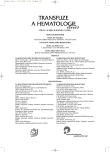New approaches to diagnosis and treatment of iron overload
Authors:
J. Čermák
Authors‘ workplace:
Ústav hematologie a krevní transfuze, Praha
Published in:
Transfuze Hematol. dnes,12, 2006, No. 3, p. 140-144.
Category:
Comprehensive Reports, Original Papers, Case Reports
Overview
Iron overload may lead to serious organ damage caused by a surplus of toxic iron. Iron overload results in most of cases as a consequence of increased influx of iron in the body, eg. in patients with hereditary hemochromatosis or in red blood cell transfusion dependent patients with anaemias with hyperplastic ineffective erythropoiesis (thalassemia, myelodysplastic syndrome). Diagnosis of iron overload is based on laboratory methods (serum ferritin, transferrin saturation), invasive methods (liver biopsy) or on non-invasive quantification of iron amount in liver or heart (magnetic resonance imaging). Clinical symptoms usually reflect the degree of organ iron load. The treatment of iron overload is based on early administration of sufficient dosis of chelating agents for prolonged time period. At present time, new oral iron chelatrors (deferiprone, deferasirox) with efficency comparable to desferioxamine are available as an alternative treatment of iron overload.
Key words:
iron overload, diagnosis, treatment, chelation, desferioxamine, deferiprone
Labels
Haematology Internal medicine Clinical oncologyArticle was published in
Transfusion and Haematology Today

2006 Issue 3
Most read in this issue
- Splenectomy in diagnostics and treatment of hematological disorders: A single-center indications, complications and results
- Plasma concentrations of cytokines and co-stimulatory molecules (interleukins IL-2, IL-4, IL-5, IL-6, IL-8, IL-10, IL-13, TNF-α, TGFβ1, sCD23, sCD40L and IL-6 receptor) in healthy blood donors
- The standardization of a biochemical laboratory determination of multiple myeloma
- New approaches to diagnosis and treatment of iron overload
